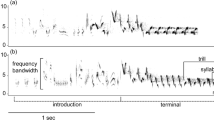Summary
We investigated the importance of song length and singing rate in stimulating female white-throated sparrows, Zonotrichia albicollis. In November 1988 ten female and one male white-throated sparrow were captured during the fall migration. To enhance the expression of sexual receptivity, the females were implanted with 17-beta-estradiol silastic pellets. Using the visual stimulus of a non-singing male to further enhance the expression of sexual receptivity in the females, we found that females gave a greater response, in the form of copulation displays, to a five-note versus a two-note version of a typical male white-throated sparrow song. Each version was played back at four songs per minute. In May 1990 birds were captured and treated as before, except that the two-note song was played at ten songs per minute and the five-note song at four songs per minute. Therefore, each female heard twenty notes per minute. In the second experiment, the females did not show a statistical difference in response to the two- and five-note song playbacks. We interpret the results of the second experiment as indicating the song rate as well as song length is important in stimulating female white-throated sparrows because increasing the rate of the two-note song brought the response up to the level of response we obtained to the five-note song played at the slower rate. We conclude that in white-throated sparrows, song output is important for female stimulation.
Similar content being viewed by others
References
Alatalo RV, Lundberg A, Glynn C (1986) Female pied flycatchers choose territory quality and not male characteristics. Nature 323:152–153
Alatalo RV, Glynn C, Lundberg A (1990) Singing rate and female attraction in the pied flycatcher: an experiment. Anim Behav 39:601–603
Baker MC, Baker AEM (1988) Vocal and visual stimuli enabling copulation behavior in female buntings. Behav Ecol Sociobiol 23:105–108
Baker MC, Bjerke TK, Lampe H, Espmark Y (1986) Sexual response of female great tits to variation in size of males' song repertoires. Am Nat 128:491–498
Boake CRB (1986) A method for testing adaptive hypotheses of mate choice. Am Nat 127:654–666
Catchpole CK (1980) Sexual selection and the evolution of complex songs among European warblers of the genus Acrocephalus. Behaviour 74:149–166
Catchpole CK, Dittami J, Leisler B (1984) Differential responses to male song repertoires in female songbirds implanted with oestradiol. Nature 312:563–564
Catchpole CK, Leisler B, Dittami J (1986) Sexual differences in the responses of captive great reed warblers (Acrocephalus arundinaceus) to variation in song structure and repertoire size. Ethology 73:69–77
Fisher RA (1958) The genetical theory of natural selection. Dover, Mineola, NY
Gottlander K (1987) Variation in the song rate of the male pied flycatcher (Ficedula hypoleuca): causes and consequences. Anim Behav 35:1037–1043
Greig-Smith PW (1982) Song-rates and parental care by individual male stonechats (Saxicola torquata). Anim Behav 30:245–252
Howard RD (1974) The influence of sexual selection and interspecific competition and mockingbird song. Evolution 28:428–438
Krebs JG (1977) The significance of song repertoires in the great tit. In: Stonehouse B, Perrins CM (eds) Evolutionary ecology. MacMillan, London, pp 47–62
Kroodsma DE (1976) Reproductive development in a female song bird: differential stimulation by quality of male song. Science 192:574–575
Lambrects M, Dhondt AA (1986) Male quality, reproduction and survival in the great tit Parus major. Behav Feel Sociobiol 19:57–63
Lambrects M, Dhondt AA (1987) Differences in singing performance between male great tits. Ardea 75:43–52
Lambrects M, Dhondt AA (1988) The anti-exhaustion hypothesis: a new hypothesis to explain song performance and song switching in the great tit. Anim Behav 36:327–334
McGregor PK, Krebs JR, Perrins CM (1981) Song repertoires and lifetime reproductive success in the great tit (Parus major). Am Nat 118:149–159
Morton ES (1982) Grading, discreteness, redundancy, and motivation-structural rules. In: Kroodsma DS, Miller EH (eds) Acoustic communication in birds, vol 1. Academic Press, New York, pp 183–212
Payne RB, Payne K (1977) Social organization and mating success in local song populations of village indigobirds, Vidua chalybeata. Z Tierpsycol 45:114–173
Radesater T, Jakobsson S, Andbjer N, Bylin A, Nystrom K (1987) Song rate and pair formation in the willow warbler (Phylloscopus trochilus). Anim Behav 35:1645–1651
Rand AS, Ryan MJ (1981) The adaptive significance of a complex vocal repertoire in a neotropical frog. Z Tierpsychol 57:209–214
Reid ML (1987) Costliness and reliability in the singing vigour of Ipswich sparrows. Anim Behav 35:1735–1743
Reid ML, Weatherhead PJ (1990) Mate-choice criteria of Ipswich sparrows: the importance of variability. Anim Behav 40:538–544
Ryan MJ (1985) The tungara frog: a study in sexual selection and communication. University of Chicago Press, Chicago
Ryan MJ, Rand S (1990) The sensory basis of sexual selection for complex calls in the tungara frog, Physalaemus pustulosus (sexual selection for sensory exploitation). Evolution 44:305–314
Ryan MJ, Fox JH, Wilczynski W, Rand SA (1990) Sexual selection for exploitation in the frog Physalaemus pustulosus. Nature 343:66–67
Searcy WA (1984) Song repertoire size and female preferences of song sparrows. Behav Ecol Sociobiol 14:281–286
Searcy WA (1986) Dual intersexual and intrasexual functions of song in red-winged blackbirds. Acta XIX Congress Int Ornithol 1373–1381
Searcy WA, Marler P (1981) A test for responsiveness to song structure and programming in female sparrows. Science 213:926–928
Searcy WA, Marler P (1984) Interspecific differences in the response of female birds to song repertoires. Z Tierpsychol 66:128–142
Siegel S (1956) Nonparametric statistics for the behavioral sciences. McGraw-Hill, New York
Trivers RL (1972) Parental investment and sexual selection. In: Campbell B (ed) Sexual selection and the descent of man. Aldine, Chicago, pp 136–179
Wasserman FE (1977) Mate attraction function of song in the white-throated sparrow. Condor 79:125–127
Wells KD, Schwartz JJ (1984) Vocal communication in a neotropical treefrog, Hyla ebraccata: advertisement calls. Anim Behav 32:405–420
Yasukawa K, Blank JL, Patterson CB (1980) Song repertoires and sexual selection in the red-winged blackbird. Behav Ecol Sociobiol 7:233–238
Author information
Authors and Affiliations
Rights and permissions
About this article
Cite this article
Wasserman, F.E., Cigliano, J.A. Song output and stimulation of the female in white-throated sparrows. Behav Ecol Sociobiol 29, 55–59 (1991). https://doi.org/10.1007/BF00164295
Received:
Accepted:
Issue Date:
DOI: https://doi.org/10.1007/BF00164295




